|
11/17/2023 2 Comments Our new paper on changing community vulnerability in the U.S. Mobile Bay from 2000 - 2020Our new paper is published in the journal Applied Spatial Analysis and Policy. Below is the abstract:
"The coastal community is confronted with heightened risks posed by climate change. Mobile Bay in the United States is a large estuarine system along the Gulf of Mexico (GOM) coast, providing critical ecosystem services for the nation. This region is however subject to increased urbanization and uncertain impacts of climate change. To ensure sustainability of this important ecosystem, it is imperative to examine the changing spatial patterns of community vulnerability to environmental changes in this region. Using data from the U.S. Census of multiple years, we investigate the changing spatial patterns of social vulnerability at the census block group level in Mobile Bay consisting of Mobile County and Baldwin County over the past 20 years (2000 – 2020). Additionally, we utilize hotspot and cluster analyses to formalize the observations of the spatiotemporal changes. Further, we examine how land use and land cover (LULC) changes co-occur with social vulnerability changes across Mobile Bay. We identify several hotspots where land cover has been converted to urban land and social vulnerability has increased. The investigation of the spatial patterns over a relatively long period helps to deepen the insight into the dynamic spatiotemporal changes of social and environmental vulnerability. This insight can better inform future plans to cope with climate change and ensure sustainability. Specifically, hotspots that have undergone urbanization and increased social vulnerability demand special attention from policy makers for future risk mitigation and disaster planning."
2 Comments
5/30/2023 0 Comments Our new paper was published in the International Journal of Disaster Risk ReductionOur new paper identifying effective hurricane risk communication tools was published in the International Journal of Disaster Risk Reduction. Below please find the abstract:
"Coastal regions such as the U.S. Atlantic and Gulf Coasts are highly vulnerable to extreme coastal hazards such as tropical cyclones and major hurricanes. The effects of these hazards pose a threat now and are expected to increase in the future, which highlights the need for coastal communities to receive and understand information regarding risks involved with these hazards. Through this study, we identify points of improvement in the tools used to communicate the short and long-term risk associated with hurricane hazards through three surveys in Mobile, AL, Savannah, GA, and Houston TX. These surveys identify public response to hurricane descriptions, Cone of Uncertainty graphics, and long-term trend graphics. Analysis of trends in responses to these communication tools identifies relationships between risk perceptions and existing factors in each study location. Further, public response to these tools is identified and analyzed using structural equation models for each location with a “response” latent variable containing information from endogenous variables in the survey. Response was measured as action intent, concern for the scenario, reported evacuation likelihood, and interpretation of long-term trends. We identify points of improvement for all three communication tools to aid in public comprehension of the information provided as well as to increase response to hurricane hazards by more effectively communicating risk information. These would help to improve comprehension and increase different responses to tropical storm and hurricane damage from high winds and storm surge with the intent to improve resident response to hazards along the U.S. Atlantic and Gulf Coasts." Our paper using participatory GIS to measure accessibility of people with movement disabilities has been published in Applied Geography. Below please find the abstract:
"Although evaluation of the accessibility of people with disability (PWDs) is necessary to design effective transportation policy measures to ensure better mobility for PWDs, little empirical research are available on this subject. This study thus aims to address this gap by developing a methodological framework and applying this framework to assessing the accessibility of earthquake evacuation routes for people with movement-related disabilities (PMDs), one type of PWDs, in the city of Dhaka, Bangladesh. Specifically, this comprehensive accessibility index is composed of four components including accessibility from home to shelter, perceived accessibility of evacuation route, accessibility of entrance of the shelter, perceived accessibility of internal circular space and entrance of the residential building. Participatory GIS approach is employed in the data collection 455 PMDs were surveyed from 13 wards of Dhaka. Accessibility of each considered parameter and the overall indicator are poor in most cases. 45.2% of the wards are found to have relatively poor conditions of overall accessibility during evacuation. Relations of various accessibility components with socio-economic factors and level of disability are examined as well. PMDs with higher levels of disabilities and older PMDs perceive lower accessibilities of evacuation routes, circulation space, and entrance gate of residence, while male and more educated PMDs perceive circular space and entrance gate of residence to be more accessible." 8/2/2022 0 Comments Open PhD Position – coastal community resilience, risk perceptions, community engagement, Nature Based Solution The Environmental Decision Making Lab at the Department of Geography of the University of Alabama seeks a geography PhD student to focus on coastal community resilience, risk perceptions, community engagement under the theme of Nature Based Solution (NBS). The broader research team is focused on developing actionable design guidance for NBS (i.e., wetland restoration) along the US Gulf Coast. Our highly interdisciplinary group includes social scientists, wetland ecologists, water resource engineers, and government agency partners. Our goal is to develop guidance for wetland restoration activities optimized to reduce flooding and increase coastal community resilience. To accomplish this goal, we will employ a combination of community engagement, wetland plant community characterization, and state-of-the-art hydrologic and hydraulic modeling.
The successful candidate will be expected to start in spring, 2023. The candidate will work closely with social scientists, wetland ecologists, and water resource engineers, and our government partners to develop, assess, and communicate NBS design alternatives by engaging stakeholders in a knowledge co-production fashion. The candidate will be expected to work with the team to develop a plan for stakeholder engagement meetings, organize and facilitate stakeholder engagement activities, collect the data from the meetings, analyze the data, and report findings in peer-reviewed manuscripts. Through this work, the candidate will also be expected to develop hypothesis driven research based on their interests. The ideal candidate will have MS degrees in a relevant field (i.e., geography, urban and regional planning, environmental sociology, ecology, environmental science, or closely related field). The candidate should be excited about working on an interdisciplinary team; interacting with community partners, and conducting both basic and applied research. Further, experience with statistical analysis and programs (e.g., R, Stata, SPSS) and geographic information systems (e.g., ArcGIS, QGIS) are required. Experience with textual analysis programs (e.g., NVivo) is preferred but not required. Additionally, experience with scripting languages (e.g., R, Python, or Matlab) are preferred but not required. For more information, please contact Dr. Wanyun Shao (wshao1@ua.edu) 3/31/2022 0 Comments Our new paper has been published in the International Journal of Disaster Risk Reduction Our paper has been published in the International Journal of Disaster Risk Reduction (Impact factor: 4.32). Below please find the abstract:
"Climate change has posed serious risks to coastal cities around the world. Effective urban disaster management calls for the coordination between the local government and residents. We propose a comprehensive framework to study urban disaster resilience under climate change with New Orleans of Louisiana in the U.S. as the study area. Municipal hazard mitigation must be sufficient to mitigate these hazards. Residents’ risk perceptions are a vital component of social vulnerability and can shape public decisions to increase disaster resiliency. Because climate change is expected to intensify, it becomes important to ensure that residents’ risk perceptions are considered when developing municipal plans to maximize regional resiliency. This research aims to identify a gap in the hazard mitigation process that can be closed to better prepare the community to manage coastal hazards. To achieve this, an online survey is distributed in the New Orleans metropolitan area to determine residents’ risk perceptions and expectations of the local government’s action. Policy analysis is conducted to identify the priorities held by municipal planners in these issues. Although there is no gap in the perception of risk and municipal mitigation of current coastal hazards, there is a gap between the municipal approach to climate change mitigation and the concern and expectation of actions the residents hold regarding the future effects of climate change. The approach to climate change should be reconsidered on a municipal level and new small-scale personal incentives should be promoted to maximize resiliency toward coastal hazards in the future." Our paper on community vulnerability to floods and hurricanes in the Gulf Coast has been recognized as the most cited paper in the journal Disasters.
9/16/2019 2 Comments Our new paper is published in the International Journal of Environmental Health Research Our new paper has been published in the International Journal of Environmental Health Research. In this paper, we examined potential factors that could affect community-level mental health across the United States. Here is the the summary:
"Mental health studies have underscored the hazardous conditions of each phase of life, from youth and pre-adulthood through adulthood in the United States. This situation calls for increased public awareness of the mental health issue and better understanding of the significant factors associated with mental health hazard. The main objective of this spatial epidemiological research is to gain greater insights into the geographic dimension displayed by the different duration of mentally unhealthy days (MUDs) across U.S. counties. Using Behavioural Risk Factor Surveillance System (BRFSS) data in 2014, we examine main factors of mental health hazard including health behaviour, clinical care, socioeconomic and physical environment, demographic, community resilience, and extreme climatic conditions. In this study, we take complex design factors such as clustering, stratification and sample weight in the BRFSS data into account by using Complex Samples General Linear Model (CSGLM). Then, spatial regression models, spatial lag and error models, are applied to examine spatial dependencies and heteroscedasticity. Econometric analysis underscores that all categories of air pollution, community resilience, and sunlight variables tested are significant push factors of mentally unhealthy days (MUDs) duration. Results of the geographic analyses indicate that counties with lower air pollution (PM2.5), higher community resilience (social, economic, infrastructure, and institutional resilience), and higher sunlight exposure had significantly lower average number of MUDs reported in the past 30 days. These findings suggest that policy makers should take air pollution, community resilience, and sunlight exposure into account when designing environmental and health policies and allocating resources to more effectively manage mental health problems." The following figure is from this paper (Ha and Shao 2019) |
|
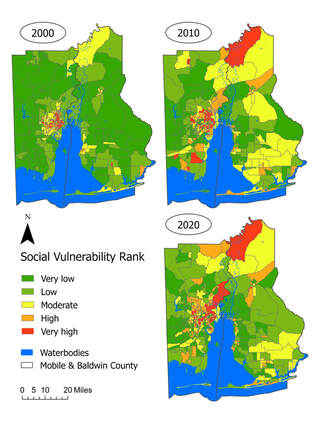
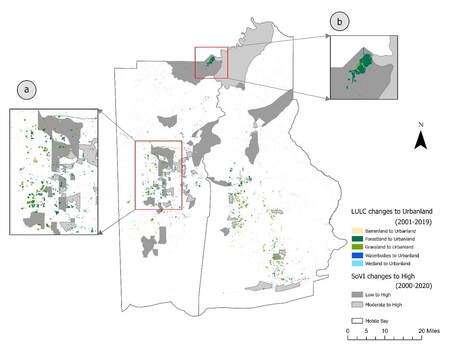
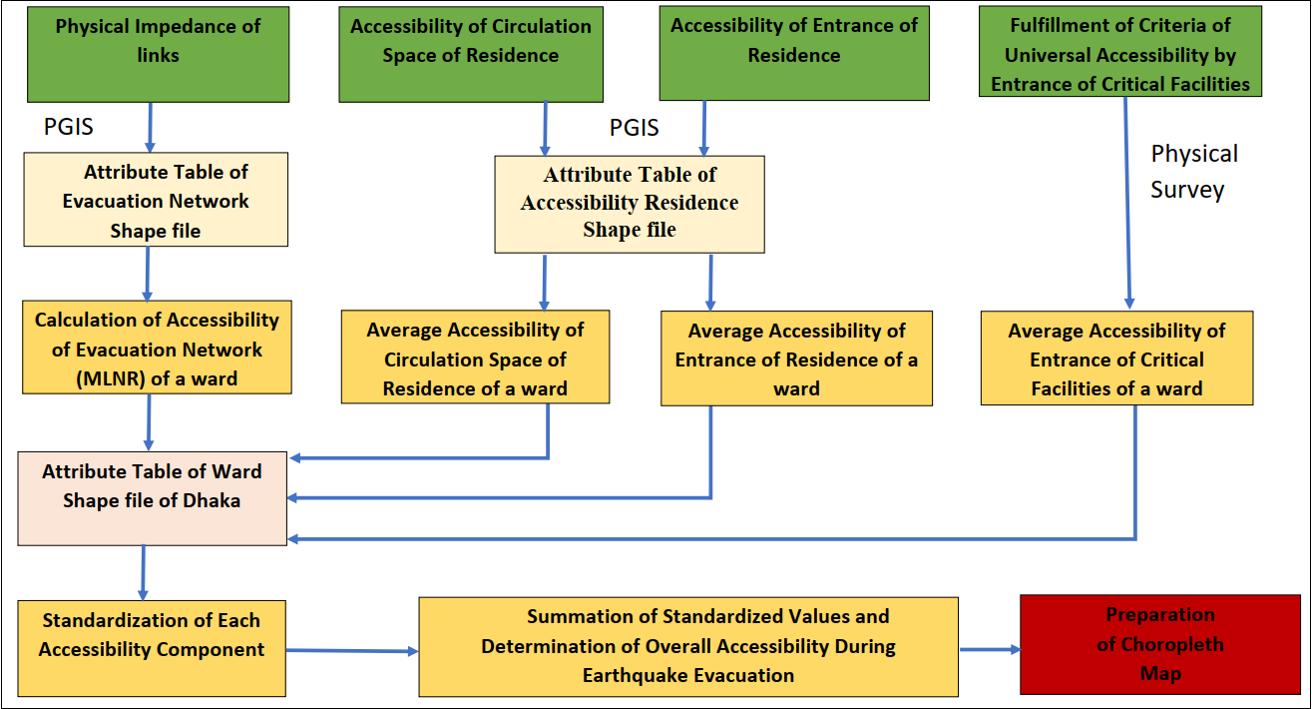
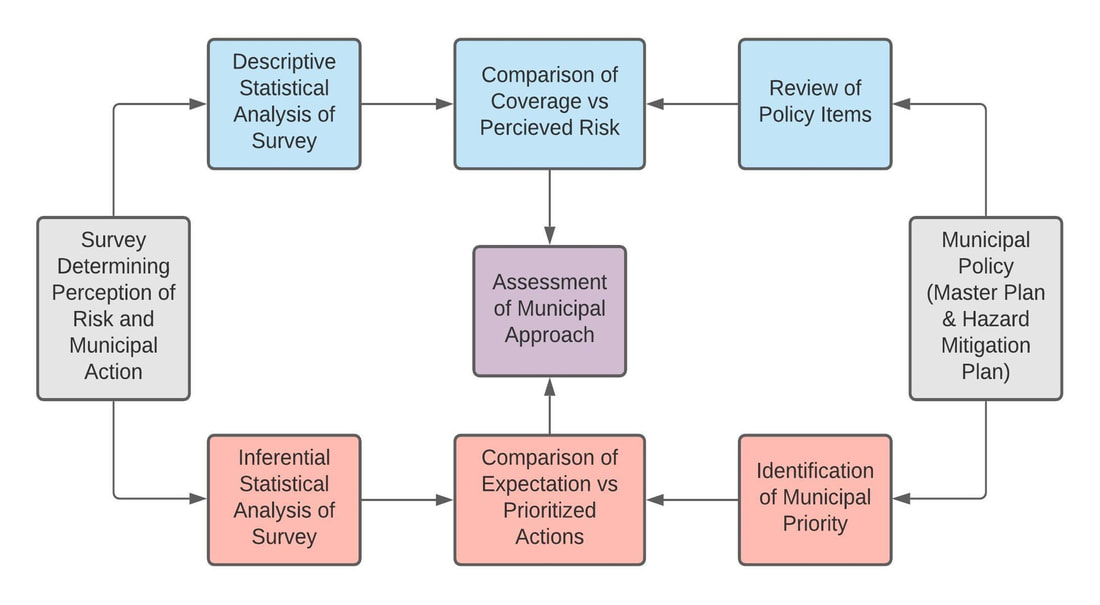
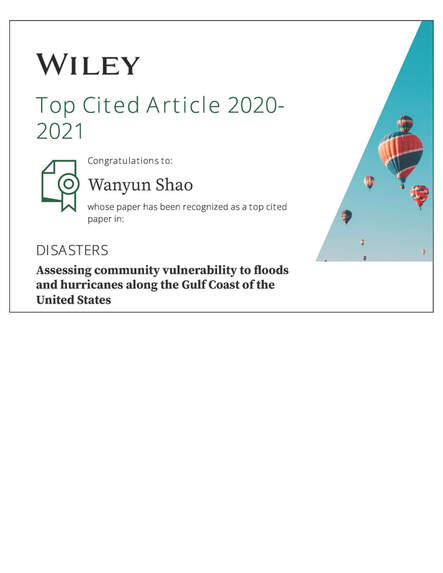
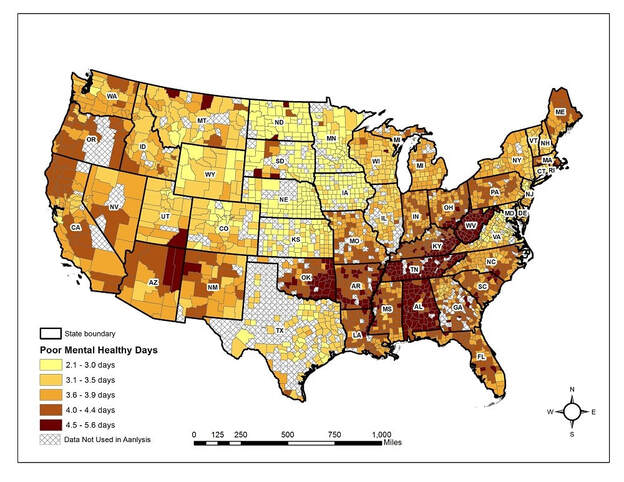


 RSS Feed
RSS Feed